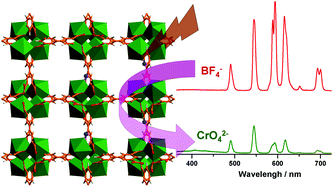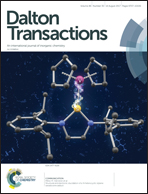Luminescent lanthanide metal–organic frameworks for chemical sensing and toxic anion detection†
Abstract
Prototype lanthanide metal–organic frameworks (LnMOFs), Ln(BTC) (Ln = Eu and Tb; BTC = benzene-1,3,5-tricarboxylate), have been considered as luminescent sensors for detecting toxic anions, while their neutral pore structures have limited the entrance and encapsulation of anions to produce highly anion-responsive photoluminescence (PL). To facilitate anions to enter the pore space of Ln(BTC), a one-pot synthesis method was proposed in which BTC was partially replaced with its structural analogue L·BF4 (H3L·BF4 = 2,4,6-tricarboxy-1-methylpyridinium tetrafluoroborate) which consists of an anion affinity site of cationic methylpyridinium. Compared to the original Ln(BTC), the co-doped cationic framework Eu0.05Tb0.95-BTC0.9L0.1 is highly sensitive for detecting different toxic anions by tuning the energy absorption of organic chromophores, the energy transfer efficiency to Ln3+ ions and the energy allocation between different Ln3+ ions in the PL spectra. We demonstrated that the Eu0.05Tb0.95-BTC0.9L0.1 PL sensor has the capability of decoding various toxic anions with a clearly differentiable and unique emission intensity ratio of 5D4 → 7F5 (Tb3+, 545 nm) to 5D0 → 7F2 (Eu3+, 618 nm) transitions (ITb/IEu). Compared to Ln(BTC), the co-doped Eu0.05Tb0.95-BTC0.9L0.1 presents self-calibrating, high distinguishable and stable PL signals for detecting toxic anions.



 Please wait while we load your content...
Please wait while we load your content...